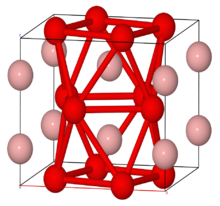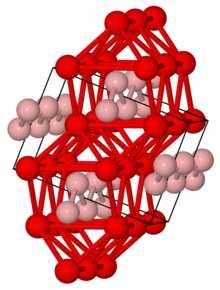Chemistry:Iron boride

| |
| Names | |
|---|---|
| IUPAC name
Iron boride
| |
| Other names
Diiron boride, Fe2B
| |
| Identifiers | |
| |
3D model (JSmol)
|
|
| EC Number |
|
PubChem CID
|
|
CompTox Dashboard (EPA)
|
|
| |
| |
| Properties | |
| Fe2B | |
| Molar mass | 122.501 g/mol[1] |
| Appearance | refractory solid |
| Density | 7.3 g/cm3[1] |
| Melting point | 1,389 °C (2,532 °F; 1,662 K)[1] |
| insoluble | |
| Structure[2] | |
| Tetragonal, tI12 | |
| I4/mc, No. 140 | |
a = 0.511 nm, b = 0.511 nm, c = 0.4249 nm
| |
Formula units (Z)
|
4 |
Except where otherwise noted, data are given for materials in their standard state (at 25 °C [77 °F], 100 kPa). | |
| Infobox references | |

| |
| Names | |
|---|---|
| IUPAC name
Iron boride
| |
| Other names
Iron monoboride, FeB
| |
| Identifiers | |
| |
3D model (JSmol)
|
|
| ChemSpider | |
| EC Number |
|
PubChem CID
|
|
| |
| |
| Properties | |
| FeB | |
| Appearance | grey powder |
| Density | ~7 g/cm3[1] |
| Melting point | 1,658 °C (3,016 °F; 1,931 K)[1] |
| insoluble | |
| Structure[3] | |
| Orthorhombic, oP8 | |
| Pnma, No. 62 | |
a = 0.4061 nm, b = 0.5506 nm, c = 0.2952 nm
| |
Formula units (Z)
|
4 |
Except where otherwise noted, data are given for materials in their standard state (at 25 °C [77 °F], 100 kPa). | |
| Infobox references | |
Iron boride refers to various inorganic compounds with the formula FexBy.[4] Two main iron borides are FeB and Fe2B. Some iron borides possess useful properties such as magnetism, electrical conductivity, corrosion resistance and extreme hardness. Some iron borides have found use as hardening coatings for iron. Iron borides have properties of ceramics such as high hardness, and properties of metal properties, such as thermal conductivity and electrical conductivity. Boride coatings on iron are superior mechanical, frictional, and anti-corrosive.[5] Iron monoboride (FeB) is a grey powder that is insoluble in water. FeB is harder than Fe2B, but is more brittle and more easily fractured upon impact.
Formation
Thermochemical Formation
Iron borides can be formed by thermochemically reacting boron rich compounds on an iron surface to form a mixture of iron borides, in a process known as boriding. There are a number of ways of forming boride coatings, including gas boriding, molten salt boriding, and pack boriding.[6] Typically carbon tetraboride (B4C) or crystalline boron, is sintered on the iron surface in a tetrafluoroborate flux to form the coatings. The boron atoms diffuse into the iron substrate between 1023 and 1373 K. They first form layers of Fe2B and then form layers of FeB.The range of compounds and compositions formed depends on the reaction conditions including temperature and surrounding environment.[6]
Bulk FeB can be formed by simple reaction between iron and boron in a high-temperature inert gas furnace[7] or in a microwave.[8]
Synthesis
Iron boride nanoparticles have been formed by reducing iron boride salts in highly coordinating solvents using sodium borohydride. They have also been prepared by reducing iron salts using sodium borohydride:[9]
- 4 FeSO4 + 8 NaBH4 +18 H2O → 2 Fe2B + 6 B(OH)3 + 25 H2 + 4 Na2SO4
Structure and Properties
The structures of FeB and Fe2B were known to be interstitial in early studies. FeB is orthorhombic and Fe2B adopts body-centered tetragonal structure.[10]
FeB
FeB has zig-zag chains of boron atoms that are coordinated by seven iron atoms. Boron atoms have a slightly distorted mono-capped trigonal prismatic iron atom coordination and two boron atom neighbors. B-B single bond distance is 178 pm, Fe-B distance is 215–220 pm, and Fe-Fe distance is 240–272 pm. Each trigonal prism shares two rectangular faces with the nearby prisms, forming infinite prism columns.[3]
FeB single crystal is taken by bond domains. Bond domains are parallel to the axis of easy magnetization and perpendicular to the axis of hard magnetization. The structure of closing domains is described as "rows and zigzags of asterisks". Its bond domains possess a distinguished direction in orientation of the boundaries of major domains with rhombic shape of closing domains.[3]
FeB is a soft ferromagnetic compound that becomes paramagnetic above ~325 °C (617 °F).[8] In air, FeB powders begins to react with the ambient oxygen above 300 °C, though bulk FeB materials are expected to be stable in air to much higher temperatures.[11] FeB is an extremely hard compound (15-22 GPa as measured by Vickers indentation), but is not sought after on borided steels because FeB layers are brittle and prone to spalling off the steel or iron.[12]
Fe2B
Fe2B contains single boron atoms in square anti-prismatic iron atom coordination. Boron atoms are separated from each other and the shortest B-B distance is 213 pm. Fe-B distance is 218 pm and Fe-Fe distance is 240–272 pm.[13]
Fe2B is a ferromagnetic compound that becomes paramagnetic at temperatures above 742 °C (1368 °F).[14] In air, Fe2B powders begin to react with the ambient oxygen above 400 °C. The high hardness of Fe2B (18.7 GPa or 1907 HV as measured by Vickers indentation)[15] is why homogeneous Fe2B layers are formed on top of iron or steel by boriding to make them more wear resistant.[16]
FeB4
Applications
Boriding, also called boronizing, is often used to improve abrasion resistance, corrosion resistance, wear resistance, and oxidation resistance. It is used in oil and gas refinery, chemical extraction, automotive, agricultural, stamping, textile extrusion and injection molding industries.[5]
Iron based coatings recently gained attention for their mechanical, frictional, and corrosion resistant properties. As compared to the ceramic or cermet type of materials people have used before, iron based materials are relatively inexpensive, less strategic, and can be produced economically by various thermal methods with ease of fabrication and machining.[17]
See also
References
- ↑ 1.0 1.1 1.2 1.3 1.4 Cite error: Invalid
<ref>tag; no text was provided for refs namedcrc - ↑ Gianoglio, C.; Badini, C. (1986). "Distribution equilibria of iron and nickel in two phase fields of the Fe-Ni-B system". Journal of Materials Science 21 (12): 4331–4334. doi:10.1007/BF01106551. Bibcode: 1986JMatS..21.4331G.
- ↑ 3.0 3.1 3.2 Lyakhova, M.B.; Pastushenkov, Y. G.; Zhdanova, O.V. (2013). "Magnetic Properties and Domain Structure of FeB Single Crystals". Metal Science and Heat Treatment 55 (1–2): 68–72. doi:10.1007/s11041-013-9581-0. Bibcode: 2013MSHT...55...68Z.
- ↑ Haynes, William M. Handbook of Chemistry and Physics (91 edition.). 2010, Boca Raton, Florida: CRC Press. ISBN:978-1439820773
- ↑ 5.0 5.1 "Boriding / Boronizing (DHB)". http://www.ibccoatings.com/boriding-boronizing-dhb. Retrieved 17 November 2014.
- ↑ 6.0 6.1 Keddam, M; Chentouf, SM (2005). "A diffusion model for describing the bilayer growth (FeB/Fe2B) during the iron powder-pack boriding". Appl. Surf. Sci. 252 (2): 393–399. doi:10.1016/j.apsusc.2005.01.016. Bibcode: 2005ApSS..252..393K.
- ↑ Natu, Varun; Kota, Sankalp S.; Barsoum, Michel W. (February 2020). "X-ray photoelectron spectroscopy of the MAB phases, MoAlB, M2AlB2 (M = Cr, Fe), Cr3AlB4 and their binary monoborides" (in en). Journal of the European Ceramic Society 40 (2): 305–314. doi:10.1016/j.jeurceramsoc.2019.09.040.
- ↑ 8.0 8.1 Bocarsly, Joshua D.; Levin, Emily E.; Humphrey, Samuel A.; Faske, Tom; Donner, Wolfgang; Wilson, Stephen D.; Seshadri, Ram (2019-07-09). "Magnetostructural Coupling Drives Magnetocaloric Behavior: The Case of MnB versus FeB" (in en). Chemistry of Materials 31 (13): 4873–4881. doi:10.1021/acs.chemmater.9b01476. ISSN 0897-4756. https://escholarship.org/uc/item/45j3v65k.
- ↑ Alyoshin, V.G. (1981). "Investigation of Composition and Chemical State of Elements in Iron Boride by the Method of X-Ray Photoelectron Spectroscopy.". Journal of Solid State Chemistry 38 (1): 105–111. doi:10.1016/0022-4596(81)90478-3. Bibcode: 1981JSSCh..38..105A.
- ↑ Joshi, A.A.; Hosmani, S.S. (2014). "Pack-Boronizing of AISI 4140 Steel: Boronizing Mechanism and the Role of Container Design". Materials and Manufacturing Processes 29 (9): 1062–1072. doi:10.1080/10426914.2014.921705.
- ↑ Carbucicchio, M.; Reverberi, R.; Palobarini, G.; Sambogna, G. (March 1989). "On the early stages of oxidation of iron borides" (in en). Hyperfine Interactions 46 (1–4): 473–479. doi:10.1007/BF02398233. ISSN 0304-3843. Bibcode: 1989HyInt..46..473C.
- ↑ Dossett, Jon L.; Totten, George E., eds (2013). "Boriding (Boronizing) of Metals[1"] (in en). Boriding (Boronizing) of Metals[1]. ASM International. pp. 709–724. doi:10.31399/asm.hb.v04a.a0005772. ISBN 978-1-62708-165-8. https://dl.asminternational.org/books/book/18/chapter/277836/boriding-boronizing-of-metals-1. Retrieved 2020-03-08.
- ↑ Kapfenberger, C.; Albert, B.; Pottgen, R.; Huppertz, H. (2006). "Structure refinements of iron borides Fe2B and FeB". Z. Kristallogr. 221 (5–7): 477. doi:10.1524/zkri.2006.221.5-7.477. Bibcode: 2006ZK....221..477K.
- ↑ Shigematsu, Toshihiko (1975-11-15). "Mössbauer and Structural Studies on (Fe 1- x Mn x ) 2 B" (in en). Journal of the Physical Society of Japan 39 (5): 1233–1238. doi:10.1143/JPSJ.39.1233. ISSN 0031-9015. Bibcode: 1975JPSJ...39.1233S.
- ↑ Ma, Shengqiang; Huang, Zhifu; Xing, Jiandong; Liu, Guangzhu; He, Yaling; Fu, Hanguang; Wang, Yong; Li, Yefei et al. (2015-01-28). "Effect of crystal orientation on microstructure and properties of bulk Fe 2 B intermetallic" (in en). Journal of Materials Research 30 (2): 257–265. doi:10.1557/jmr.2014.383. ISSN 0884-2914. Bibcode: 2015JMatR..30..257M. https://www.cambridge.org/core/product/identifier/S0884291414003835/type/journal_article.
- ↑ Totten, George E., ed (2017). "Wear and Galling Resistance of Borided (Boronized) Metal Surfaces" (in en). Friction, Lubrication, and Wear Technology. ASM International. pp. 653–660. doi:10.31399/asm.hb.v18.a0006420. ISBN 978-1-62708-192-4. https://dl.asminternational.org/books/book/50/chapter/632564/wear-and-galling-resistance-of-borided-boronized. Retrieved 2020-03-08.
- ↑ Zhdanova, O.V.; Lyakhova, M.B.; Pastushenkov, Y.G. (May 2013). "Magnetic Properties and Domain Structure of FeB Single Crystals". Met. Sci. Heat Treat. 55 (1–2): 68–72. doi:10.1007/s11041-013-9581-0. Bibcode: 2013MSHT...55...68Z.
 |

